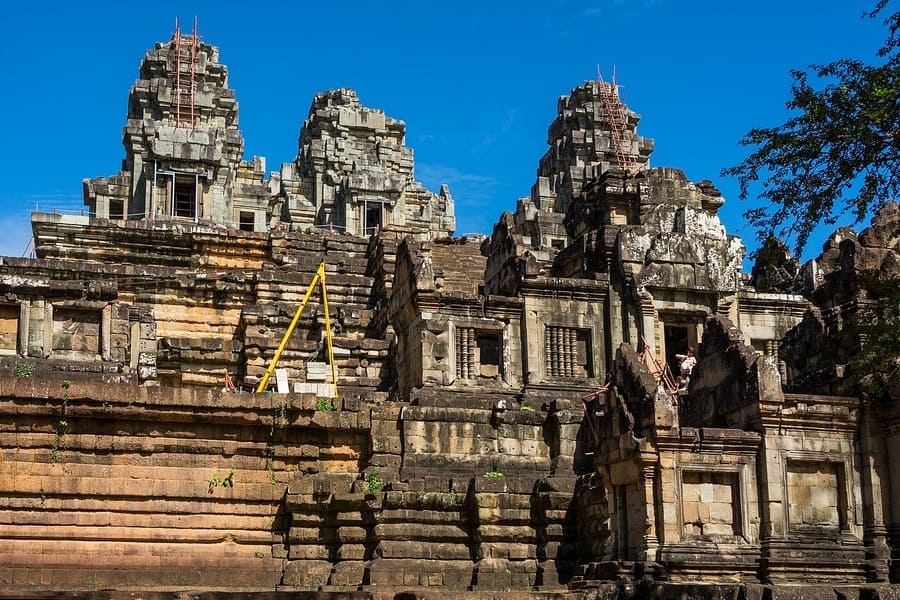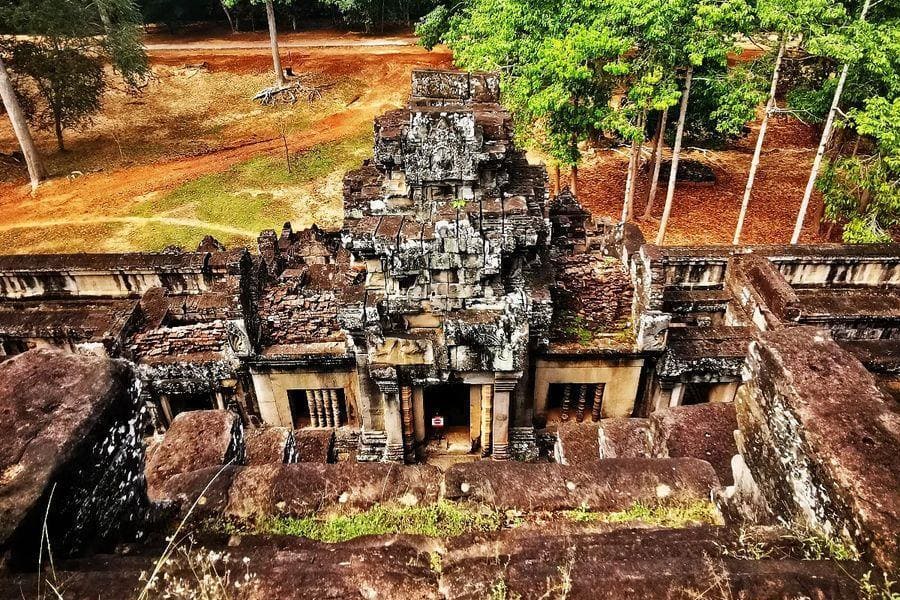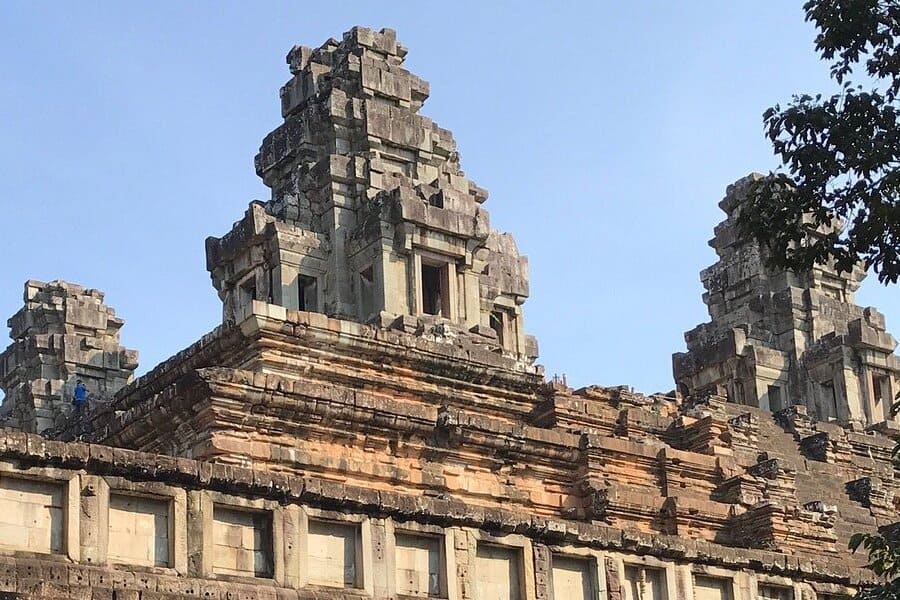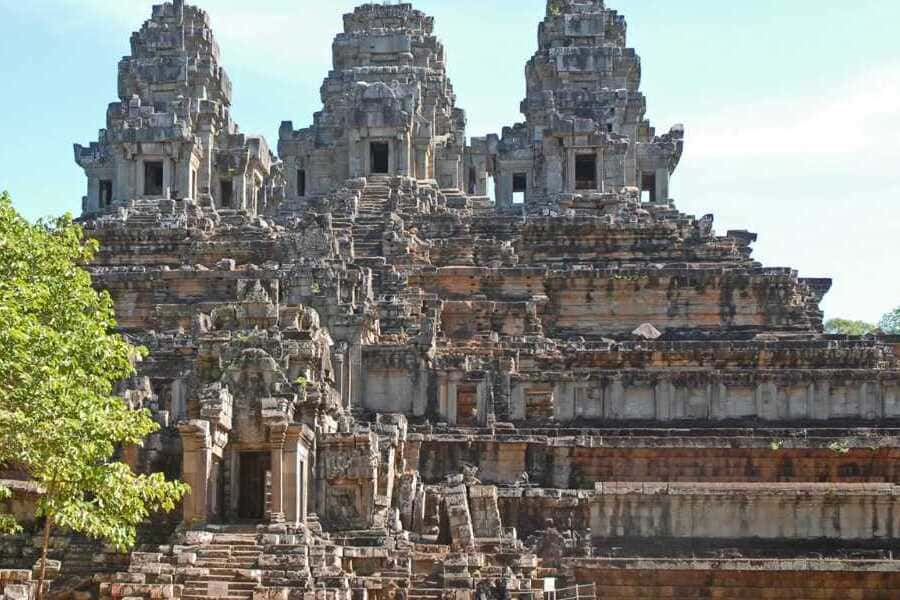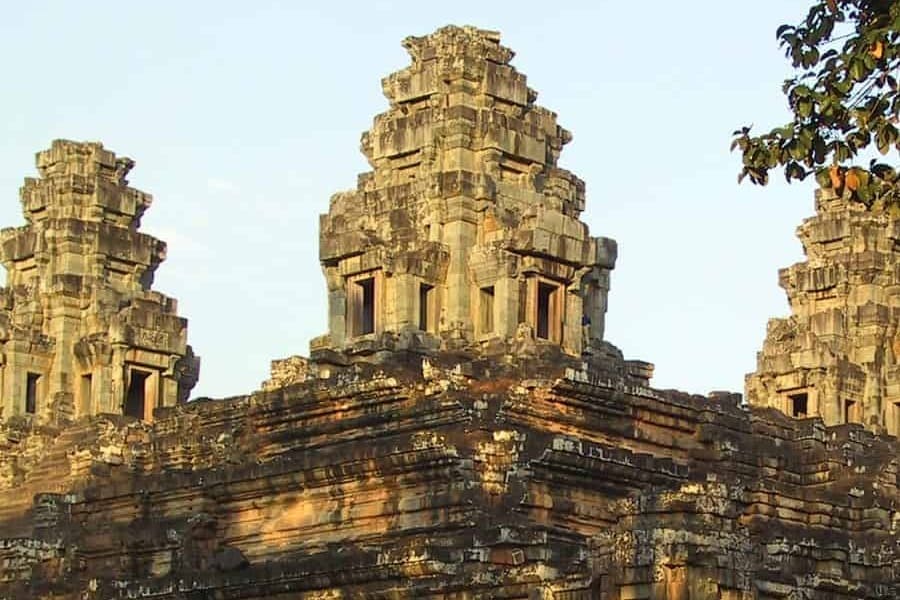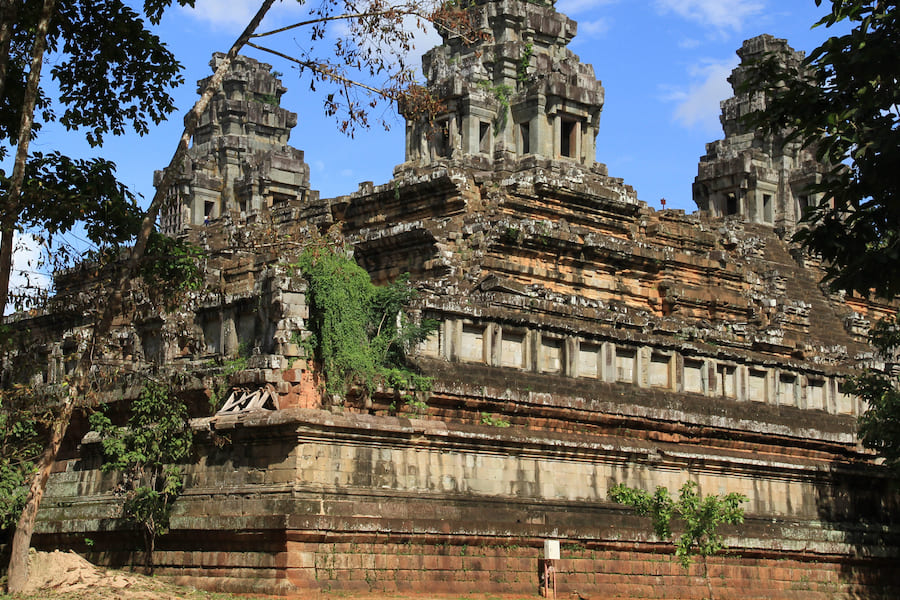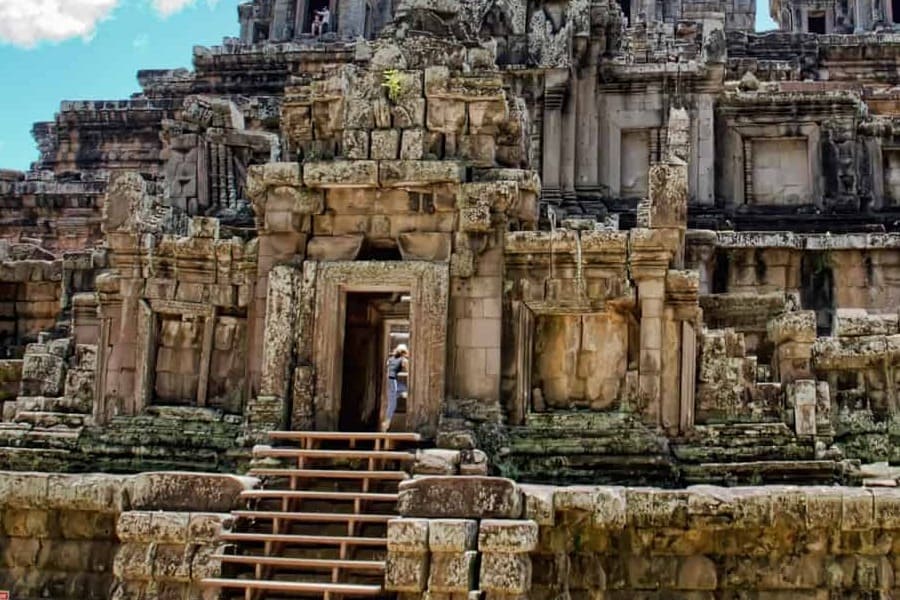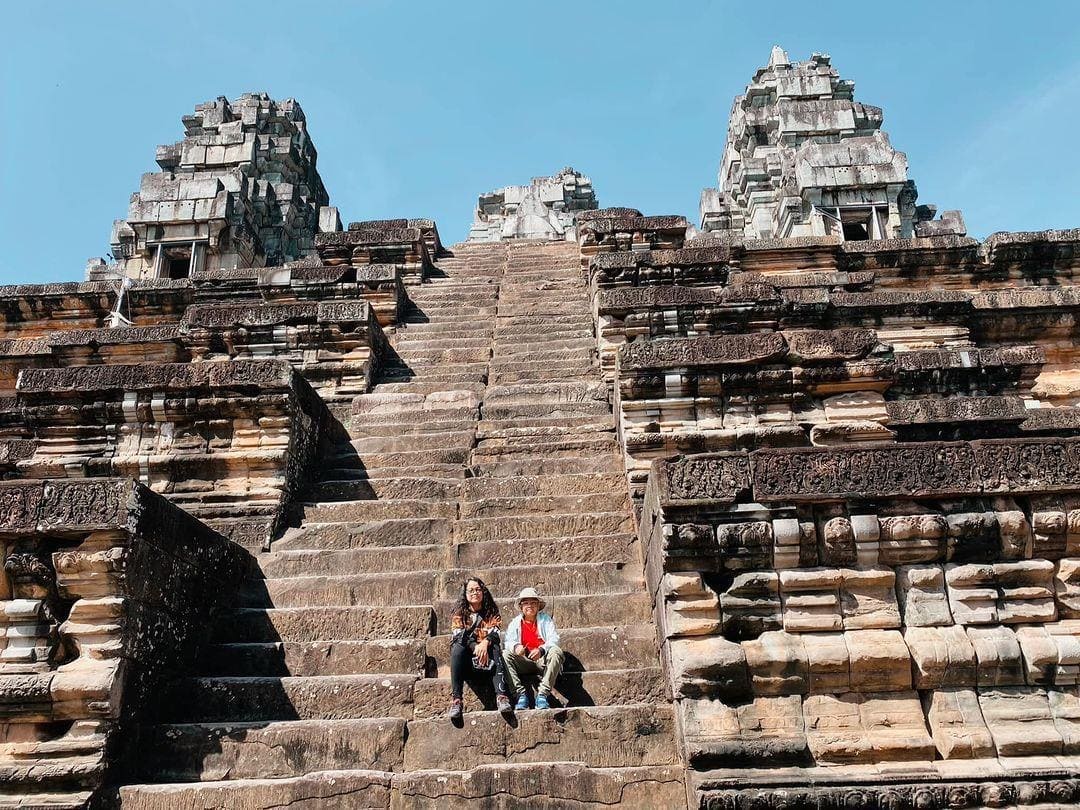Welcome to Ta Keo, an awe-inspiring testament to Cambodia's rich history and architectural marvels, nestled within the renowned Angkor complex. As part of the captivating landscape of Angkor Archaeological Park, Ta Keo stands tall as an ancient temple mountain crafted from sandstone, beckoning travelers on their Cambodia holiday packages to explore its mystical beauty and unravel its secrets.
Contents
The History of Ta Keo Temple
The history of Ta Keo, an ancient temple mountain within Cambodia's Angkor complex, traces back to the late 10th century during the reign of King Jayavarman V of the Khmer Empire. Commissioned as a state temple dedicated to the Hindu god Shiva, Ta Keo was intended to serve as a grand monument to the king's devotion and the empire's power.
Construction of Ta Keo began around 975 CE, and the temple was envisioned to surpass even the grandeur of its predecessors in scale and design. The temple's unique architectural style, characterized by its towering pyramidal structure and multi-tiered layout, reflected the Khmer Empire's ambition to create a symbolic representation of Mount Meru, the mythical abode of the gods in Hindu cosmology.
However, historical records suggest that Ta Keo's construction was abruptly halted, possibly due to political unrest or a shift in royal patronage. As a result, the temple remains unfinished, lacking the elaborate carvings and embellishments characteristic of other Angkorian temples.
Despite its incomplete state, Ta Keo's massive sandstone blocks and imposing silhouette stand as a testament to the Khmer Empire's architectural prowess and engineering ingenuity. Over the centuries, Ta Keo has weathered the ravages of time and nature, bearing witness to Cambodia's tumultuous history and the enduring legacy of its ancient civilizations.
Today, Ta Keo remains a prominent landmark within the Angkor Archaeological Park, drawing visitors from around the world to marvel at its enigmatic beauty and ponder the mysteries of its unfinished construction. As one of the lesser-known temples in the Angkor complex, Ta Keo offers a unique opportunity to explore Cambodia's rich history and cultural heritage, inviting visitors to delve into the ancient secrets of this remarkable monument.
The Architectural Features of Ta Keo Temple
Ta Keo, an ancient temple mountain within Cambodia's Angkor complex, boasts architectural details that reflect the grandeur and sophistication of Khmer temple design. Constructed entirely from sandstone, Ta Keo's imposing silhouette rises majestically above the surrounding landscape, adorned with intricate carvings and symbolic elements. Here are some architectural details that distinguish Ta Keo:
Pyramidal Structure: Ta Keo is renowned for its towering pyramidal structure, characterized by steep staircases and ascending tiers. The temple's design is reminiscent of the mythical Mount Meru, with each level representing a different realm of the Hindu cosmos.
Multi-Tiered Layout: The temple is built on five levels, each progressively smaller than the one below it, creating a stepped pyramid effect. Visitors ascend a series of steep staircases to reach the central sanctuary at the summit, where they are rewarded with panoramic views of the surrounding landscape.
Sandstone Construction: Ta Keo is constructed entirely from sandstone blocks, meticulously cut and fitted together to create a seamless façade. The temple's sandstone blocks are notable for their size and weight, some weighing several tons, attesting to the Khmer Empire's advanced engineering capabilities.
Symmetrical Design: Ta Keo's architecture exhibits a symmetrical layout, with four towering sanctuaries positioned at the cardinal points of the compass. Each sanctuary is adorned with intricate carvings and decorative elements, although much of the temple's ornamentation remains unfinished.
Bas-Reliefs: While Ta Keo lacks the elaborate bas-reliefs found in other Angkorian temples, some areas of the temple feature remnants of carved lintels, pediments, and decorative motifs. These carvings depict scenes from Hindu mythology and royal processions, offering glimpses into the temple's intended decorative scheme.
What to do at Ta Keo Temple?
Here are some activities to consider during your visit to Ta Keo:
Ascend the Pyramid: Begin your visit by ascending the steep staircases of Ta Keo's pyramid-like structure. As you climb higher, take in the panoramic views of the surrounding jungle and nearby temples. The ascent may be challenging, but reaching the summit offers a rewarding sense of accomplishment.
Explore the Central Sanctuary: At the top of Ta Keo's pyramid, you'll find the central sanctuary, which once housed a statue of the Hindu god Shiva. While the sanctuary is now empty, take a moment to admire the temple's architectural details and imagine the rituals and ceremonies that once took place here.
Admire the Architecture: Take time to appreciate Ta Keo's architectural features, including its symmetrical layout, massive sandstone blocks, and intricate carvings. Despite its unfinished state, the temple's imposing silhouette and grandeur offer insights into the Khmer Empire's ambitious vision and artistic ingenuity.
Reflect and Meditate: Ta Keo's serene surroundings make it an ideal spot for quiet reflection and meditation. Find a peaceful corner of the temple complex to sit and contemplate the temple's history, the passage of time, and your own place within the ancient ruins.
Learn about Khmer History: Take advantage of interpretive signs or guided tours to learn more about Ta Keo's history and significance within the Angkor complex. Gain insights into the temple's construction, religious significance, and the cultural context of the Khmer Empire.
Connect with Nature: Surround yourself with the sights and sounds of nature as you explore Ta Keo. Listen to the chirping of birds, feel the gentle breeze rustling through the trees, and marvel at the lush greenery that envelops the temple complex.
The best time to visit Ta Keo Temple
As for the best times to visit Ta Keo, it's advisable to plan your visit during the early morning or late afternoon to avoid the intense heat of the midday sun. Additionally, visiting during the shoulder seasons of spring (March to May) or autumn (October to November) can provide more comfortable temperatures and fewer crowds compared to the peak tourist season.
Visiting tips for Tourists
Navigating Ta Keo, an ancient temple mountain within Cambodia's Angkor complex, requires some preparation and consideration due to its unique architectural features and remote location.
- Wear Comfortable Footwear: Ta Keo's steep staircases and uneven surfaces can be challenging to navigate, especially in hot and humid weather. Wear comfortable footwear with good traction to ensure stability and minimize the risk of slipping.
- Bring Sun Protection: As Ta Keo is largely exposed to the elements, it's essential to protect yourself from the sun's harsh rays. Bring sunscreen, a wide-brimmed hat, sunglasses, and lightweight clothing to shield yourself from sunburn and heat exhaustion.
- Stay Hydrated: Be sure to bring an ample supply of water to stay hydrated throughout your visit to Ta Keo. The temple's remote location means that amenities such as water fountains or vendors may be limited or nonexistent, so it's best to come prepared.
- Mind the Stairs: Ta Keo's staircases are steep and narrow, requiring caution when ascending or descending. Take your time and use handrails where available to ensure your safety. Avoid visiting Ta Keo during peak tourist hours to minimize crowding and allow for a more leisurely exploration of the temple.
- Respect the Sacred Space: Ta Keo is a religious site with cultural significance to the Cambodian people. Show respect for the temple and its surroundings by refraining from loud noise, littering, or engaging in disrespectful behavior. Follow any posted signs or instructions from temple staff to help preserve Ta Keo for future generations.
Ta Keo Temple Tour Guide
How to get to Ta Keo Temple?
To get to Ta Keo Temple, located in the Angkor Archaeological Park near Siem Reap, Cambodia, you have several transportation options:
- Tuk-Tuk
- Availability: Tuk-tuks are widely available in Siem Reap.
- Cost: Typically ranges from $15 to $25 USD for a full day rental, including stops at other temples.
- Duration: Around 30-40 minutes from Siem Reap to Ta Keo.
- Pros: Convenient and allows flexibility to visit multiple temples.
- Bicycle
- Availability: Many guesthouses and hotels in Siem Reap rent bicycles.
- Cost: About $2 to $5 USD per day.
- Duration: Approximately 1-1.5 hours depending on your pace.
- Pros: Eco-friendly and offers a more intimate experience with the surroundings.
- Motorbike
- Availability: Motorbikes can be rented in Siem Reap, though self-driving by tourists is often restricted.
- Cost: Around $10 to $15 USD per day.
- Duration: Roughly 20-30 minutes.
- Pros: Faster than a bicycle and offers more freedom than a tuk-tuk.
- Private Car
- Availability: Hotels and travel agencies in Siem Reap offer private car services.
- Cost: Usually between $30 to $50 USD for a day.
- Duration: About 20-30 minutes.
- Pros: Comfortable, air-conditioned, and suitable for groups or families.
- Guided Tour
- Availability: Various tour operators offer guided tours, including transport.
- Cost: Prices vary but generally start at $40 USD per person.
- Duration: Depends on the tour schedule; typically includes multiple temples.
- Pros: Includes knowledgeable guides and often covers multiple sites.
Entry Requirements
Angkor Pass: Required to enter the Angkor Archaeological Park. Available as 1-day, 3-day, or 7-day passes.
- 1-day pass: $37 USD
- 3-day pass: $62 USD (valid for 10 days)
- 7-day pass: $72 USD (valid for 1 month)
Opening hour
Daily, from 7:30 am - 17:30 pm
In conclusion, Ta Keo stands as a remarkable testament to Cambodia's rich history and architectural legacy, nestled within the illustrious Angkor complex. As an ancient temple mountain crafted from sandstone, Ta Keo's imposing presence and intricate design captivate visitors on their Cambodia tours, offering a glimpse into the grandeur of the Khmer Empire's architectural achievements.

